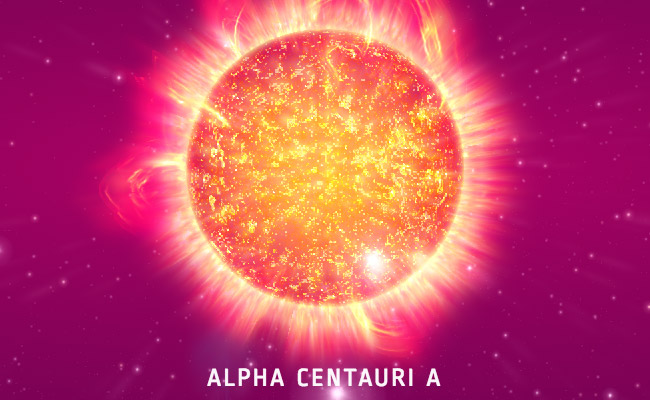Alpha Centauri A – Star Facts

Alpha Centauri A is part of a two-star system located in the Centaurus constellation. This star is similar to the Sun, except it is 23 percent larger and has 151.9 times its brightness, making it the fourth most luminous in the night sky. It also spins a bit faster than our Sun completing an orbit every 22 days.
Constellation Home
Alpha Centauri A calls the Centaurus constellation home. It is known by many other names; Rigil Kent, Rigil Kentaurus A, or Toliman. Rigil Kent and Rigil Kentaurus are Roman words derived from Arabic – Rijl Qanṭuris from the phrase, Rijl al-Qanṭuris – meaning “the foot of the centaur,” of which this star marks. Toliman is also derived from Arabic (al-Zulman) meaning, “the ostriches.” Alpha Centauri is the nearest star system to the Sun and is located 4.37 light-years from Earth; 25.8 trillion miles (41.5 trillion kilometers). It is considered a circumpolar South star of latitude 29 degrees South, which means it never sets below the horizon in that area of the world. This is also one of the stars that point to the Southern Cross asterism.
Observation
Although Alpha Centauri is a bright star system, it cannot be seen with the naked eye; however for amateur enthusiasts you can see this star through a good pair of binoculars or a small telescope. It will appear as a single star, even though Alpha Centauri is actually composed of at least two components.

Star Characteristics and Features
Alpha Centauri is considered a visual binary star, meaning it appears as one star when viewed with the naked eye. It is composed of Alpha Centauri A, Alpha Centauri B and a third star known as Proxima Centauri (Alpha Centauri C). Alpha Centauri A is considered a main sequence star that is similar to the Sun, except it is 23 percent larger and has 151.9 times its brightness. It spins a bit faster than the Sun reaching a projected rotational velocity of 2.7, with a rotational period of about 22 days.
Brightness of the Star
The binary system of Alpha Centauri shines with a combined apparent magnitude of -0.27. This makes it one of the brightest stars that can be seen from Earth. Alpha Centauri A, being the brightest component of this binary system, shines with an apparent magnitude of -0.01 and an absolute magnitude of 4.38. This makes it the fourth most luminous star in the night sky.
History and Mythology
The Alpha Centauri star was first discovered by an English explorer, Robert Hues and was listed on his Tractatus de Globe in 1592. But its historical significance doesn’t end there. The Chinese culture know this star as “The Second Star of the Southern Gate,” in reference to the asterism it forms with Epsilon Centauri. In Australia, Alpha Centauri (and Beta Centauri) are known as Bermbermgl. The Boorong tribe of Northwestern Victoria believe these stars symbolize two brothers (who were considered heroes) who killed the Emu; represented by Coalsack Nebula in the Crux constellation. Because of Alpha Centauri’s position in the heavens, there are no Roman or Greek mythologies associated with it; however, our popular culture has borrowed its presence for such hit shows as, Star Trek, Lost in Space, Babylon 5, Transformers and Avatar to name just a few. Interestingly enough, Alpha Centauri was first discovered by a Jesuit Priest in Puducherry, India, not an astronomer. Jean Richaud was observing a passing comet when he observed this binary delight.
Alpha Centauri A is not just another twinkling celestial object, it has some cold hard facts and true significance. So if you have a chance to view Alpha Centauri A, be sure to take a peek at one of the most intriguing views you may ever experience.
